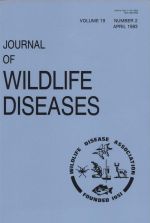Duck plague (DP) carrier mallards (Anas platyrhynchos) were subjected to seven environmental and physiological conditions in an attempt to stimulate DP virus shedding. The conditions were: food quality, social interaction, reproductive state, time dependency of food and water, noise, exercise, and sex of bird. Cloacal and oral swabs were taken daily for 10 days and assayed for DP virus content. The stimulated carrier ducks shed DP virus intermittently in amounts up to 108 ffus/swab/day (the highest 10-fold dilution still showing specific fluorescence). Unstimulated DP carrier ducks shed only up to 103 ffus/swab/day. Reproductive state and exercise were the only two factors that acted in concert to stimulate the shedding of virus in oral secretions.
How to translate text using browser tools
1 April 1983
THE INFLUENCE OF SEVEN ENVIRONMENTAL AND PHYSIOLOGICAL FACTORS ON DUCK PLAGUE VIRUS SHEDDING BY CARRIER MALLARDS
E. C. Burgess,
T. M. Yuill





